2006 INFINITI M35 warning
[x] Cancel search: warningPage 5406 of 5621
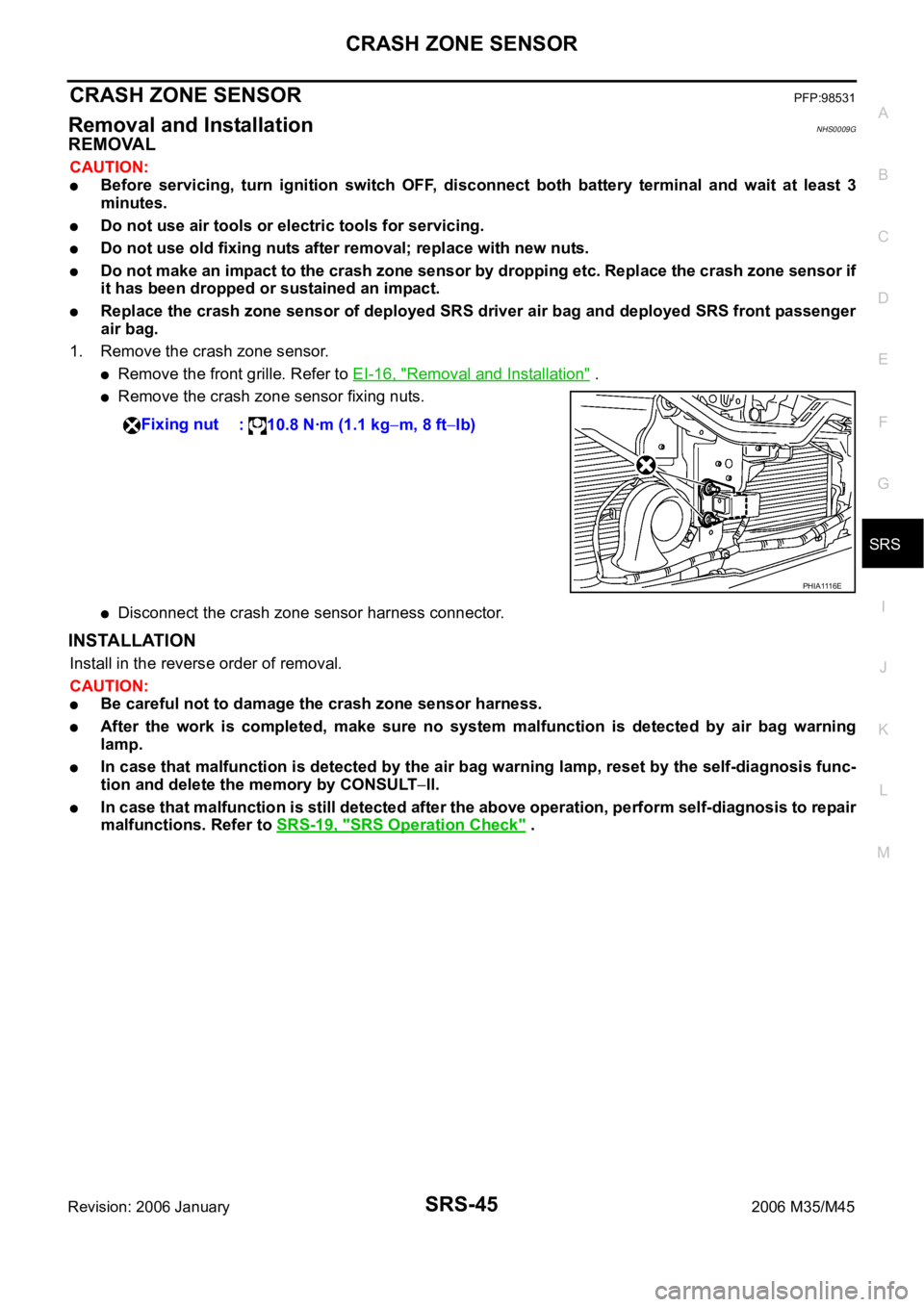
CRASH ZONE SENSOR
SRS-45
C
D
E
F
G
I
J
K
L
MA
B
SRS
Revision: 2006 January2006 M35/M45
CRASH ZONE SENSORPFP:98531
Removal and InstallationNHS0009G
REMOVAL
CAUTION:
Before servicing, turn ignition switch OFF, disconnect both battery terminal and wait at least 3
minutes.
Do not use air tools or electric tools for servicing.
Do not use old fixing nuts after removal; replace with new nuts.
Do not make an impact to the crash zone sensor by dropping etc. Replace the crash zone sensor if
it has been dropped or sustained an impact.
Replace the crash zone sensor of deployed SRS driver air bag and deployed SRS front passenger
air bag.
1. Remove the crash zone sensor.
Remove the front grille. Refer to EI-16, "Removal and Installation" .
Remove the crash zone sensor fixing nuts.
Disconnect the crash zone sensor harness connector.
INSTALLATION
Install in the reverse order of removal.
CAUTION:
Be careful not to damage the crash zone sensor harness.
After the work is completed, make sure no system malfunction is detected by air bag warning
lamp.
In case that malfunction is detected by the air bag warning lamp, reset by the self-diagnosis func-
tion and delete the memory by CONSULT
ll.
In case that malfunction is still detected after the above operation, perform self-diagnosis to repair
malfunctions. Refer to SRS-19, "
SRS Operation Check" . Fixing nut
: 10.8 Nꞏm (1.1 kg
m, 8 ftlb)
PHIA1116E
Page 5407 of 5621
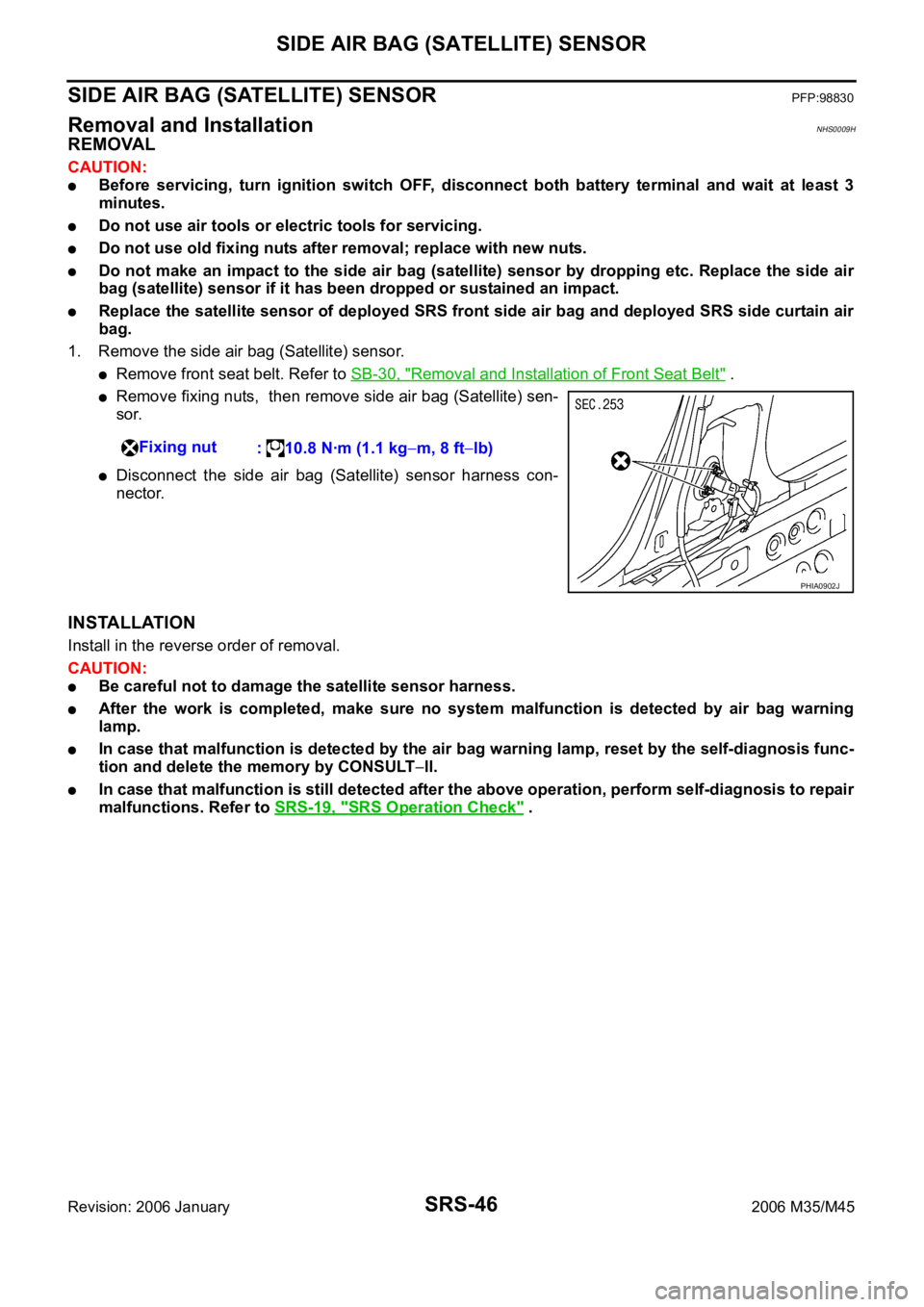
SRS-46
SIDE AIR BAG (SATELLITE) SENSOR
Revision: 2006 January2006 M35/M45
SIDE AIR BAG (SATELLITE) SENSORPFP:98830
Removal and InstallationNHS0009H
REMOVAL
CAUTION:
Before servicing, turn ignition switch OFF, disconnect both battery terminal and wait at least 3
minutes.
Do not use air tools or electric tools for servicing.
Do not use old fixing nuts after removal; replace with new nuts.
Do not make an impact to the side air bag (satellite) sensor by dropping etc. Replace the side air
bag (satellite) sensor if it has been dropped or sustained an impact.
Replace the satellite sensor of deployed SRS front side air bag and deployed SRS side curtain air
bag.
1. Remove the side air bag (Satellite) sensor.
Remove front seat belt. Refer to SB-30, "Removal and Installation of Front Seat Belt" .
Remove fixing nuts, then remove side air bag (Satellite) sen-
sor.
Disconnect the side air bag (Satellite) sensor harness con-
nector.
INSTALLATION
Install in the reverse order of removal.
CAUTION:
Be careful not to damage the satellite sensor harness.
After the work is completed, make sure no system malfunction is detected by air bag warning
lamp.
In case that malfunction is detected by the air bag warning lamp, reset by the self-diagnosis func-
tion and delete the memory by CONSULT
ll.
In case that malfunction is still detected after the above operation, perform self-diagnosis to repair
malfunctions. Refer to SRS-19, "
SRS Operation Check" . Fixing nut
: 10.8 Nꞏm (1.1 kg
m, 8 ftlb)
PHIA0902J
Page 5409 of 5621
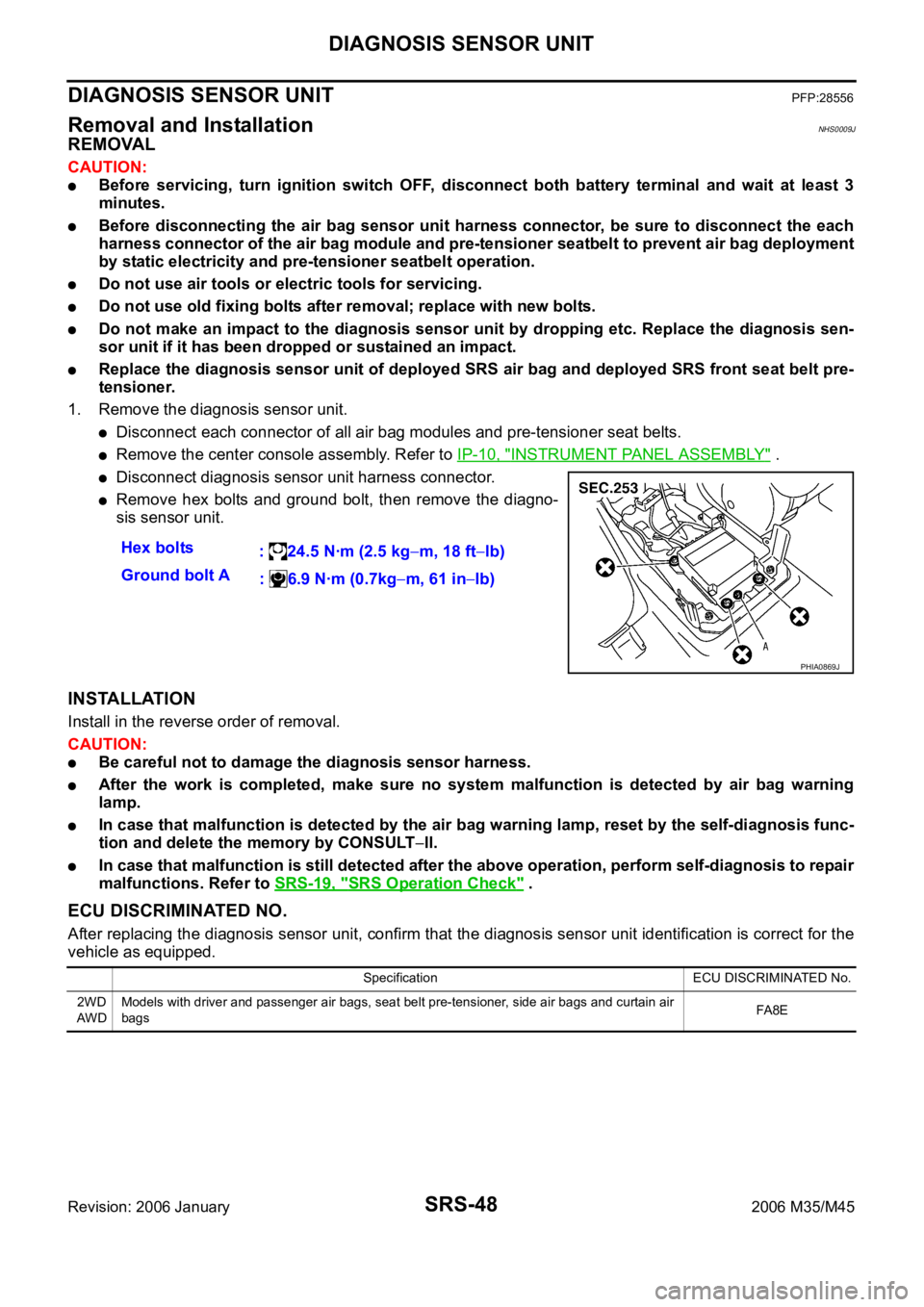
SRS-48
DIAGNOSIS SENSOR UNIT
Revision: 2006 January2006 M35/M45
DIAGNOSIS SENSOR UNITPFP:28556
Removal and InstallationNHS0009J
REMOVAL
CAUTION:
Before servicing, turn ignition switch OFF, disconnect both battery terminal and wait at least 3
minutes.
Before disconnecting the air bag sensor unit harness connector, be sure to disconnect the each
harness connector of the air bag module and pre-tensioner seatbelt to prevent air bag deployment
by static electricity and pre-tensioner seatbelt operation.
Do not use air tools or electric tools for servicing.
Do not use old fixing bolts after removal; replace with new bolts.
Do not make an impact to the diagnosis sensor unit by dropping etc. Replace the diagnosis sen-
sor unit if it has been dropped or sustained an impact.
Replace the diagnosis sensor unit of deployed SRS air bag and deployed SRS front seat belt pre-
tensioner.
1. Remove the diagnosis sensor unit.
Disconnect each connector of all air bag modules and pre-tensioner seat belts.
Remove the center console assembly. Refer to IP-10, "INSTRUMENT PANEL ASSEMBLY" .
Disconnect diagnosis sensor unit harness connector.
Remove hex bolts and ground bolt, then remove the diagno-
sis sensor unit.
INSTALLATION
Install in the reverse order of removal.
CAUTION:
Be careful not to damage the diagnosis sensor harness.
After the work is completed, make sure no system malfunction is detected by air bag warning
lamp.
In case that malfunction is detected by the air bag warning lamp, reset by the self-diagnosis func-
tion and delete the memory by CONSULT
ll.
In case that malfunction is still detected after the above operation, perform self-diagnosis to repair
malfunctions. Refer to SRS-19, "
SRS Operation Check" .
ECU DISCRIMINATED NO.
After replacing the diagnosis sensor unit, confirm that the diagnosis sensor unit identification is correct for the
vehicle as equipped.Hex bolts
: 24.5 Nꞏm (2.5 kg
m, 18 ftlb)
Ground bolt A
: 6.9 Nꞏm (0.7kg
m, 61 inlb)
PHIA0869J
Specification ECU DISCRIMINATED No.
2WD
AW DModels with driver and passenger air bags, seat belt pre-tensioner, side air bags and curtain air
bagsFA 8 E
Page 5411 of 5621
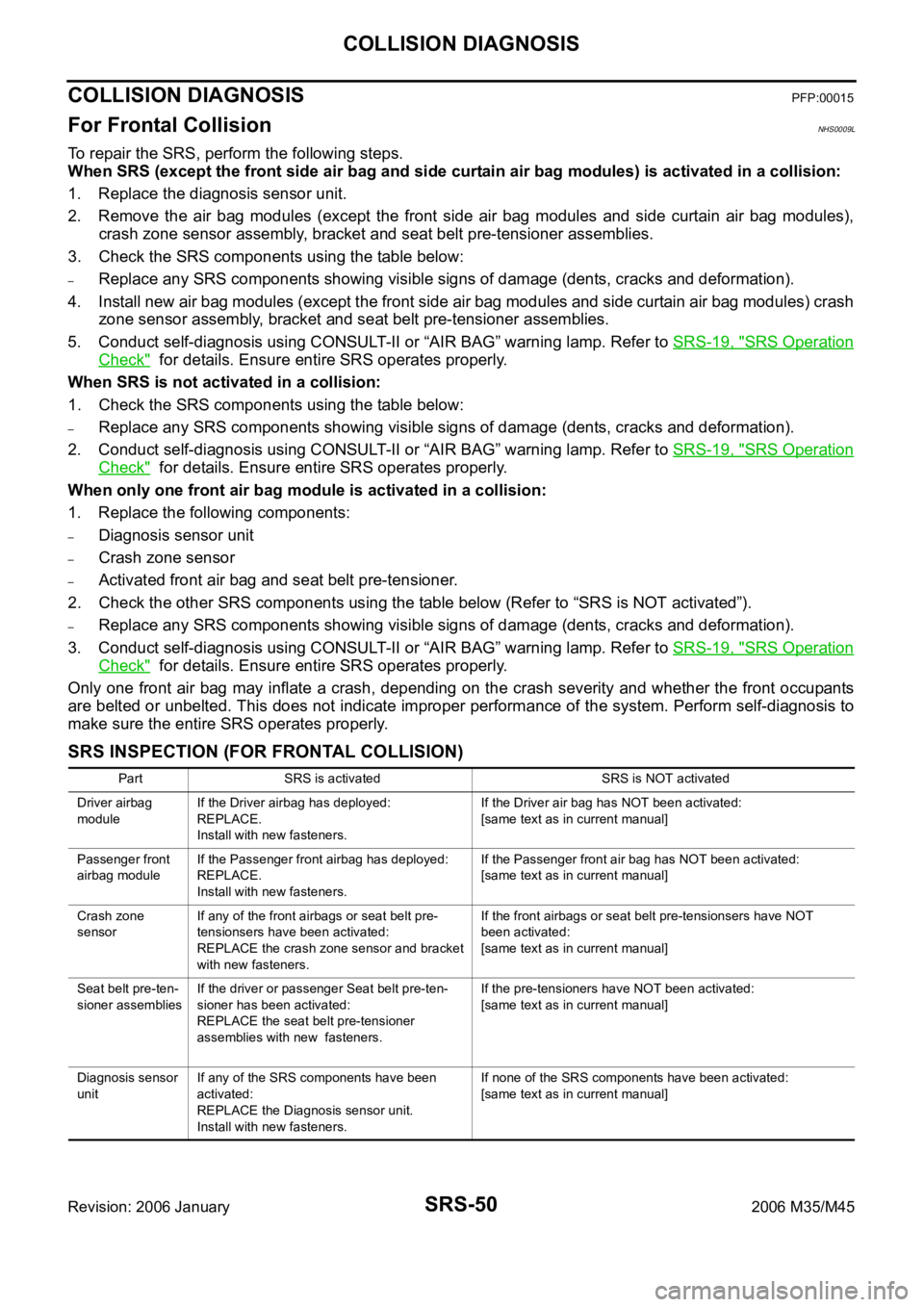
SRS-50
COLLISION DIAGNOSIS
Revision: 2006 January2006 M35/M45
COLLISION DIAGNOSISPFP:00015
For Frontal CollisionNHS0009L
To repair the SRS, perform the following steps.
When SRS (except the front side air bag and side curtain air bag modules) is activated in a collision:
1. Replace the diagnosis sensor unit.
2. Remove the air bag modules (except the front side air bag modules and side curtain air bag modules),
crash zone sensor assembly, bracket and seat belt pre-tensioner assemblies.
3. Check the SRS components using the table below:
–Replace any SRS components showing visible signs of damage (dents, cracks and deformation).
4. Install new air bag modules (except the front side air bag modules and side curtain air bag modules) crash
zone sensor assembly, bracket and seat belt pre-tensioner assemblies.
5. Conduct self-diagnosis using CONSULT-II or “AIR BAG” warning lamp. Refer to SRS-19, "
SRS Operation
Check" for details. Ensure entire SRS operates properly.
When SRS is not activated in a collision:
1. Check the SRS components using the table below:
–Replace any SRS components showing visible signs of damage (dents, cracks and deformation).
2. Conduct self-diagnosis using CONSULT-II or “AIR BAG” warning lamp. Refer to SRS-19, "
SRS Operation
Check" for details. Ensure entire SRS operates properly.
When only one front air bag module is activated in a collision:
1. Replace the following components:
–Diagnosis sensor unit
–Crash zone sensor
–Activated front air bag and seat belt pre-tensioner.
2. Check the other SRS components using the table below (Refer to “SRS is NOT activated”).
–Replace any SRS components showing visible signs of damage (dents, cracks and deformation).
3. Conduct self-diagnosis using CONSULT-II or “AIR BAG” warning lamp. Refer to SRS-19, "
SRS Operation
Check" for details. Ensure entire SRS operates properly.
Only one front air bag may inflate a crash, depending on the crash severity and whether the front occupants
are belted or unbelted. This does not indicate improper performance of the system. Perform self-diagnosis to
make sure the entire SRS operates properly.
SRS INSPECTION (FOR FRONTAL COLLISION)
Part SRS is activated SRS is NOT activated
Driver airbag
moduleIf the Driver airbag has deployed:
REPLACE.
Install with new fasteners.If the Driver air bag has NOT been activated:
[same text as in current manual]
Passenger front
airbag moduleIf the Passenger front airbag has deployed:
REPLACE.
Install with new fasteners.If the Passenger front air bag has NOT been activated:
[same text as in current manual]
Crash zone
sensorIf any of the front airbags or seat belt pre-
tensionsers have been activated:
REPLACE the crash zone sensor and bracket
with new fasteners. If the front airbags or seat belt pre-tensionsers have NOT
been activated:
[same text as in current manual]
Seat belt pre-ten-
sioner assembliesIf the driver or passenger Seat belt pre-ten-
sioner has been activated:
REPLACE the seat belt pre-tensioner
assemblies with new fasteners. If the pre-tensioners have NOT been activated:
[same text as in current manual]
Diagnosis sensor
unitIf any of the SRS components have been
activated:
REPLACE the Diagnosis sensor unit.
Install with new fasteners.If none of the SRS components have been activated:
[same text as in current manual]
Page 5413 of 5621
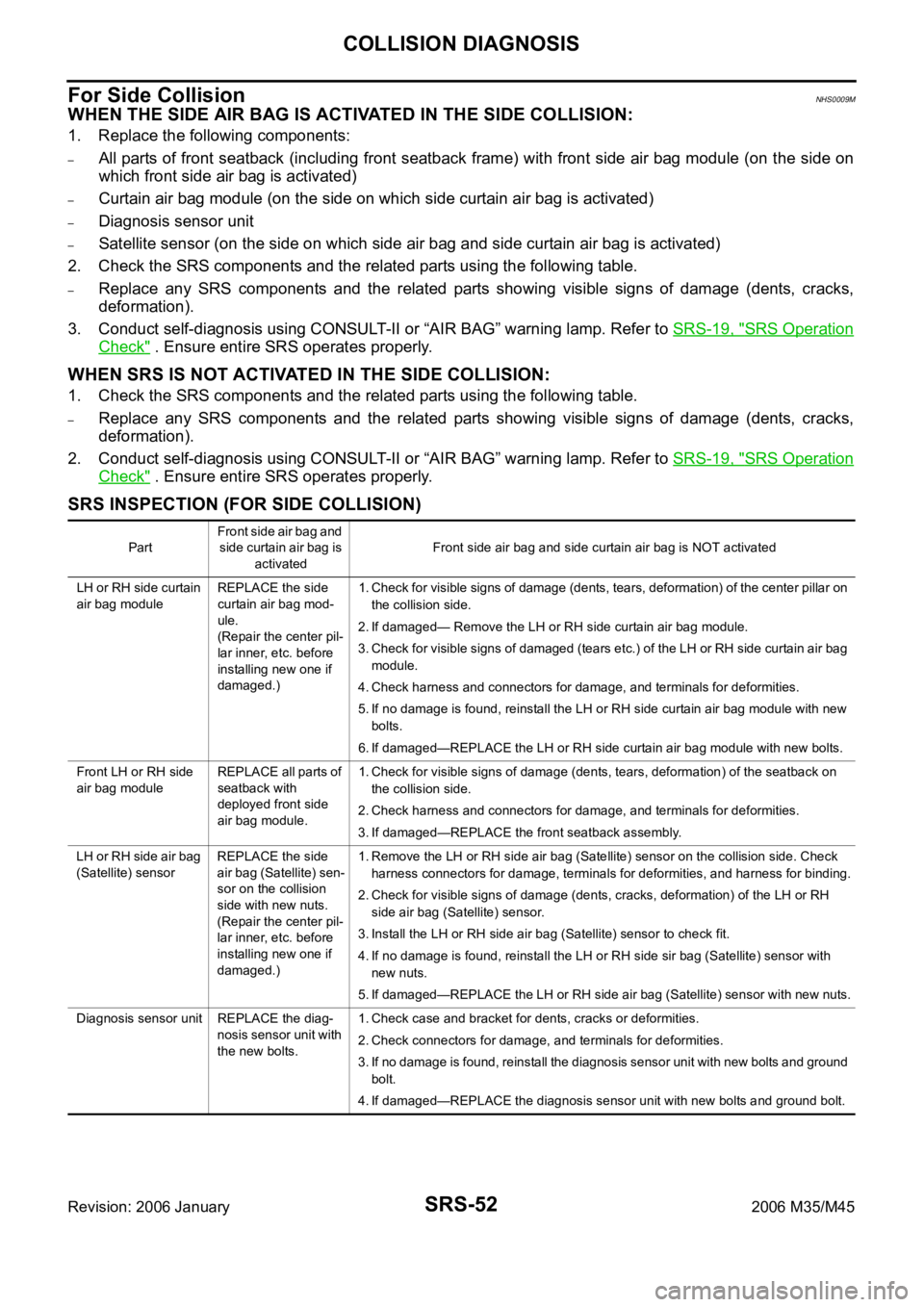
SRS-52
COLLISION DIAGNOSIS
Revision: 2006 January2006 M35/M45
For Side CollisionNHS0009M
WHEN THE SIDE AIR BAG IS ACTIVATED IN THE SIDE COLLISION:
1. Replace the following components:
–All parts of front seatback (including front seatback frame) with front side air bag module (on the side on
which front side air bag is activated)
–Curtain air bag module (on the side on which side curtain air bag is activated)
–Diagnosis sensor unit
–Satellite sensor (on the side on which side air bag and side curtain air bag is activated)
2. Check the SRS components and the related parts using the following table.
–Replace any SRS components and the related parts showing visible signs of damage (dents, cracks,
deformation).
3. Conduct self-diagnosis using CONSULT-II or “AIR BAG” warning lamp. Refer to SRS-19, "
SRS Operation
Check" . Ensure entire SRS operates properly.
WHEN SRS IS NOT ACTIVATED IN THE SIDE COLLISION:
1. Check the SRS components and the related parts using the following table.
–Replace any SRS components and the related parts showing visible signs of damage (dents, cracks,
deformation).
2. Conduct self-diagnosis using CONSULT-II or “AIR BAG” warning lamp. Refer to SRS-19, "
SRS Operation
Check" . Ensure entire SRS operates properly.
SRS INSPECTION (FOR SIDE COLLISION)
PartFront side air bag and
side curtain air bag is
activatedFront side air bag and side curtain air bag is NOT activated
LH or RH side curtain
air bag moduleREPLACE the side
curtain air bag mod-
ule.
(Repair the center pil-
lar inner, etc. before
installing new one if
damaged.)1. Check for visible signs of damage (dents, tears, deformation) of the center pillar on
the collision side.
2. If damaged— Remove the LH or RH side curtain air bag module.
3. Check for visible signs of damaged (tears etc.) of the LH or RH side curtain air bag
module.
4. Check harness and connectors for damage, and terminals for deformities.
5. If no damage is found, reinstall the LH or RH side curtain air bag module with new
bolts.
6. If damaged—REPLACE the LH or RH side curtain air bag module with new bolts.
Front LH or RH side
air bag moduleREPLACE all parts of
seatback with
deployed front side
air bag module.1. Check for visible signs of damage (dents, tears, deformation) of the seatback on
the collision side.
2. Check harness and connectors for damage, and terminals for deformities.
3. If damaged—REPLACE the front seatback assembly.
LH or RH side air bag
(Satellite) sensorREPLACE the side
air bag (Satellite) sen-
sor on the collision
side with new nuts.
(Repair the center pil-
lar inner, etc. before
installing new one if
damaged.)1. Remove the LH or RH side air bag (Satellite) sensor on the collision side. Check
harness connectors for damage, terminals for deformities, and harness for binding.
2. Check for visible signs of damage (dents, cracks, deformation) of the LH or RH
side air bag (Satellite) sensor.
3. Install the LH or RH side air bag (Satellite) sensor to check fit.
4. If no damage is found, reinstall the LH or RH side sir bag (Satellite) sensor with
new nuts.
5. If damaged—REPLACE the LH or RH side air bag (Satellite) sensor with new nuts.
Diagnosis sensor unit REPLACE the diag-
nosis sensor unit with
the new bolts.1. Check case and bracket for dents, cracks or deformities.
2. Check connectors for damage, and terminals for deformities.
3. If no damage is found, reinstall the diagnosis sensor unit with new bolts and ground
bolt.
4. If damaged—REPLACE the diagnosis sensor unit with new bolts and ground bolt.
Page 5416 of 5621
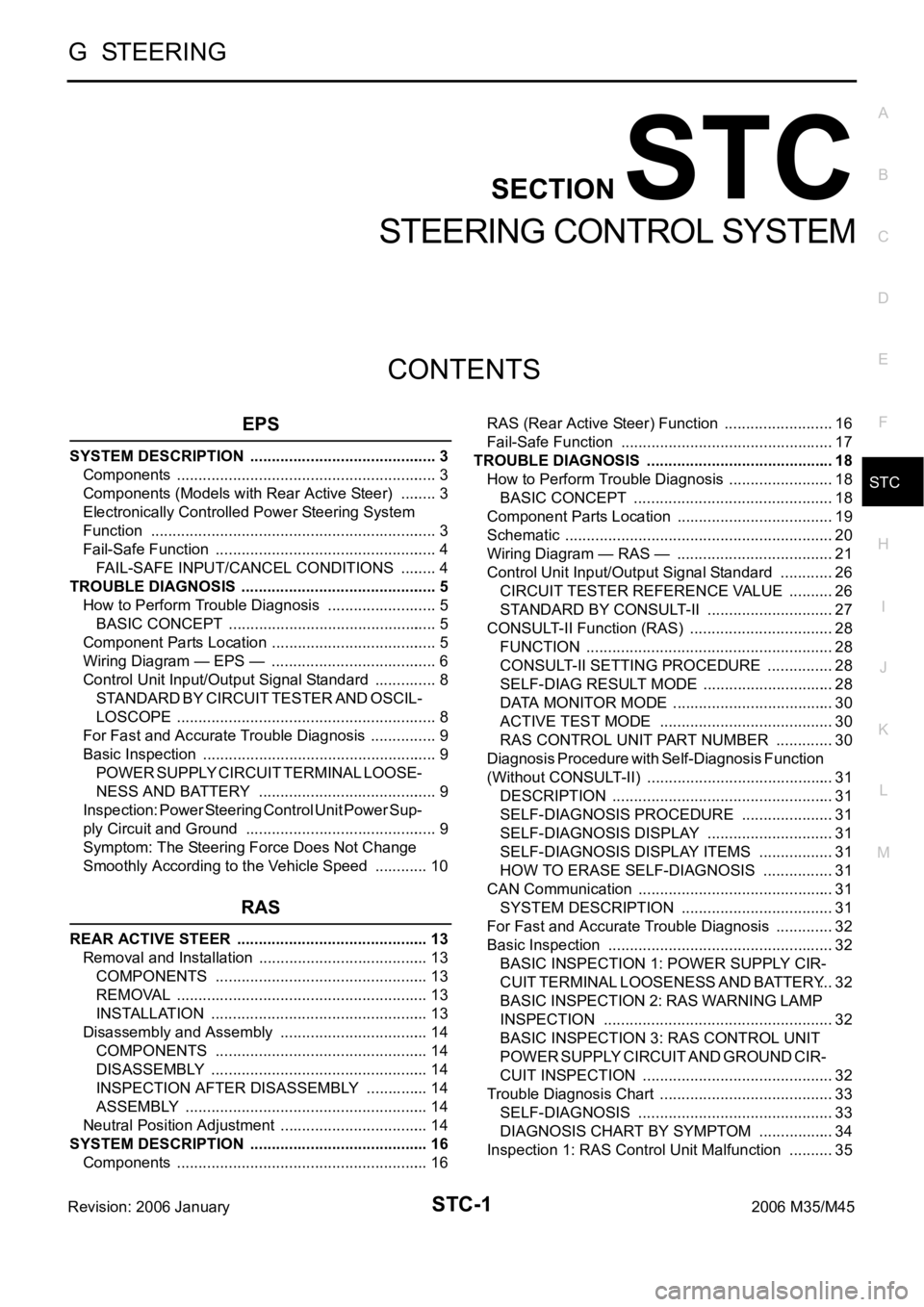
STC-1
STEERING CONTROL SYSTEM
G STEERING
CONTENTS
C
D
E
F
H
I
J
K
L
M
SECTION STC
A
B
STC
Revision: 2006 January2006 M35/M45
STEERING CONTROL SYSTEM
EPS
SYSTEM DESCRIPTION ............................................ 3
Components ............................................................. 3
Components (Models with Rear Active Steer) ......... 3
Electronically Controlled Power Steering System
Function ................................................................... 3
Fail-Safe Function .................................................... 4
FAIL-SAFE INPUT/CANCEL CONDITIONS ......... 4
TROUBLE DIAGNOSIS .............................................. 5
How to Perform Trouble Diagnosis .......................... 5
BASIC CONCEPT ................................................. 5
Component Parts Location ....................................... 5
Wiring Diagram — EPS — ....................................... 6
Control Unit Input/Output Signal Standard ............... 8
STANDARD BY CIRCUIT TESTER AND OSCIL-
LOSCOPE ........................................................
..... 8
For Fast and Accurate Trouble Diagnosis ................ 9
Basic Inspection ....................................................... 9
POWER SUPPLY CIRCUIT TERMINAL LOOSE-
NESS AND BATTERY .......................................... 9
Inspection: Power Steering Control Unit Power Sup-
ply Circuit and Ground ............................................. 9
Symptom: The Steering Force Does Not Change
Smoothly According to the Vehicle Speed ............. 10
RAS
REAR ACTIVE STEER ............................................. 13
Removal and Installation ........................................ 13
COMPONENTS .................................................. 13
REMOVAL ........................................................
... 13
INSTALLATION ................................................... 13
Disassembly and Assembly ................................... 14
COMPONENTS .................................................. 14
DISASSEMBLY ................................................... 14
INSPECTION AFTER DISASSEMBLY ............... 14
ASSEMBLY ......................................................... 14
Neutral Position Adjustment ................................... 14
SYSTEM DESCRIPTION .......................................... 16
Components ........................................................... 16RAS (Rear Active Steer) Function .......................... 16
Fail-Safe Function .................................................. 17
TROUBLE DIAGNOSIS ............................................ 18
How to Perform Trouble Diagnosis ......................... 18
BASIC CONCEPT ............................................... 18
Component Parts Location ..................................... 19
Schematic ............................................................... 20
Wiring Diagram — RAS — ..................................... 21
Control Unit Input/Output Signal Standard ............. 26
CIRCUIT TESTER REFERENCE VALUE ........... 26
STANDARD BY CONSULT-II .............................. 27
CONSULT-II Function (RAS) .................................. 28
FUNCTION .......................................................
... 28
CONSULT-II SETTING PROCEDURE ................ 28
SELF-DIAG RESULT MODE ............................... 28
DATA MONITOR MODE ...................................... 30
ACTIVE TEST MODE ......................................... 30
RAS CONTROL UNIT PART NUMBER .............. 30
Diagnosis Procedure with Self-Diagnosis Function
(Without CONSULT-II) ............................................ 31
DESCRIPTION .................................................... 31
SELF-DIAGNOSIS PROCEDURE ...................... 31
SELF-DIAGNOSIS DISPLAY .............................. 31
SELF-DIAGNOSIS DISPLAY ITEMS .................. 31
HOW TO ERASE SELF-DIAGNOSIS ................. 31
CAN Communication .............................................. 31
SYSTEM DESCRIPTION .................................... 31
For Fast and Accurate Trouble Diagnosis .............. 32
Basic Inspection ..................................................... 32
BASIC INSPECTION 1: POWER SUPPLY CIR-
CUIT TERMINAL LOOSENESS AND BATTERY ... 32
BASIC INSPECTION 2: RAS WARNING LAMP
INSPECTION ...................................................... 32
BASIC INSPECTION 3: RAS CONTROL UNIT
POWER SUPPLY CIRCUIT AND GROUND CIR-
CUIT INSPECTION ............................................. 32
Trouble Diagnosis Chart ......................................... 33
SELF-DIAGNOSIS .............................................. 33
DIAGNOSIS CHART BY SYMPTOM .................. 34
Inspection 1: RAS Control Unit Malfunction ........... 35
Page 5417 of 5621

STC-2Revision: 2006 January2006 M35/M45 Inspection 2: Motor Power Supply System ............. 35
Inspection 3: RAS Motor Output Malfunction ......... 37
Inspection 4: Vehicle Speed Signal ........................ 38
Inspection 5: Steering Angle Signal Malfunction .... 38
Inspection 6: Rear Main Signal and Rear Sub Signal
Malfunction ............................................................. 40
Inspection 7: VDC Malfunction ............................... 42
Inspection 8: Engine Speed Signal Malfunction ..... 43
Inspection 9: CAN Communication System Mal-
function ................................................................... 43Inspection 10: Stop Lamp Switch Harness ............. 44
Inspection 11: RAS Warning Lamp Harness ........... 44
Diagnosis Chart by Symptom 1 .............................. 46
Diagnosis Chart by Symptom 2 .............................. 46
Check RAS Static/Dynamic Characteristics ............ 48
Component Parts Inspection ................................... 49
RAS MOTOR RELAY ........................................... 49
RAS MOTOR ....................................................... 49
REAR WHEEL STEERING ANGLE SENSOR .... 49
Page 5431 of 5621
![INFINITI M35 2006 Factory Service Manual STC-16
[RAS]
SYSTEM DESCRIPTION
Revision: 2006 January2006 M35/M45
SYSTEM DESCRIPTIONPFP:00000
ComponentsNGS000E8
RAS (Rear Active Steer) FunctionNGS000E9
A. RAS control unit B. Model following contro INFINITI M35 2006 Factory Service Manual STC-16
[RAS]
SYSTEM DESCRIPTION
Revision: 2006 January2006 M35/M45
SYSTEM DESCRIPTIONPFP:00000
ComponentsNGS000E8
RAS (Rear Active Steer) FunctionNGS000E9
A. RAS control unit B. Model following contro](/manual-img/42/57023/w960_57023-5430.png)
STC-16
[RAS]
SYSTEM DESCRIPTION
Revision: 2006 January2006 M35/M45
SYSTEM DESCRIPTIONPFP:00000
ComponentsNGS000E8
RAS (Rear Active Steer) FunctionNGS000E9
A. RAS control unit B. Model following control C. Target vehicle dynamics model
D. Rear wheel steering angle com-
mand value operationE. Rear wheel steering angle servo F. Vehicle speed signal (CAN)
G. Steering angle signal (CAN) H. Vehicle speed sensor I. Steering angle sensor
J. RAS actuator assembly
SGIA1241E
Part name Function
RAS control unit
Calculate the vehicle speed signal from CAN communication and the signals from steering
angle sensor and rear wheel steering angle sensor by a computer, and then control the rear
wheel steering angle.
Fail-safe function is activated when the electrical system is malfunctioning. The output signal
to the actuator is turned OFF during this mode. At that time, the RAS warning lamp illumi-
nates and indicates the system is malfunctioning.
It performs the communication control function with other control units via CAN communica-
tion.
This enables system diagnosis with CONSULT-II.
RAS actuatorThe efficiency of the rear wheel steer improves by locating the electric motor actuator into the
lower link of rear suspension.
Steering angle sensor
Measure the steering angle and send it to RAS control unit via CAN communication.
It is shared with the steering angle sensor for VDC.
Rear wheel steering angle sensor
It sends the rear wheel steering angle status to RAS control unit. The accuracy of rear wheel
steer improves by comparing the vehicle speed signal from CAN communication with the
rear wheel steering angle target value calculated from the wheel angle sensor signal, and it
controls them.
There are 2 types of rear wheel steering angle sensors (main/sub). If one of them is malfunc-
tioning, the other operates the fail-safe mode and stops the control.
RAS warning lamp
It turns on when the fail-safe function is operated and indicates that a RAS control malfunc-
tion has occurred.
It turns on when ignition switch turns on and turns off after the engine is started.
It indicates the suspect system by blinking when performing the self-diagnosis (without CON-
SULT-II).